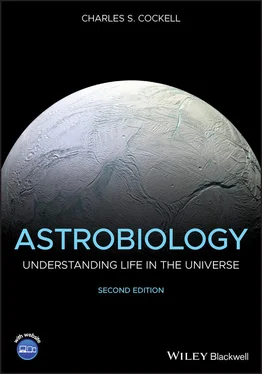16 Chapter 16Figure 16.1 A taxidermy specimen of the passenger or wild pigeon.Figure 16.2 The changing diversity of genera of marine organisms during the ...Figure 16.3 Dale Russell's intelligent dinosaur shown alongside a model of a...Figure 16.4 An iridium spike at the Cretaceous–Paleogene boundary in the roc...Figure 16.5 Evidence for geological changes at the K–Pg boundary associated ...Figure 16.6 The dinosaurs face an impact winter.Figure 16.7 The site of the Chicxulub impact crater in Mexico, proposed coll...Figure 16.8 The Deccan traps (in red) erupted toward the end of the Cretaceo...Figure 16.9 A correspondence between some (but not all) extinctions (red) an...Figure 16.10 The remnants of a supernova explosion. This one is SN 1987A, at...Figure 16.11 The trilobites. Just one group destroyed by the end-Permian ext...Figure 16.12 A foram showing its calcium carbonate shell. This specimen is a...Figure 16.13 Lystrosaurus, a pig-sized survivor of the end-Permian extinctio...Figure 16.14 The frequency and energy of impact events. Energy is given in t...Figure 16.15 Deflecting asteroids. A concept for deflecting an asteroid on a...
17 Chapter 17Figure 17.1 A simplified Venn diagram showing some of the basic requirements...Figure 17.2 The habitable zone in our Solar System. The dark green zone show...Figure 17.3 Habitable zones around different stars. (a) The general principl...Figure 17.4 A diagram showing the temperature and pressure profile t...Figure 17.5 The carbonate–silicate cycle. (a) One principal mechanism by whi...Figure 17.6 Multiple factors interact to influence the habitability of Earth...Figure 17.7 An early model showing the upper and lower value of the obliquit...Figure 17.8 Environments in the Universe can be split into three types. In m...Figure 17.9 One model that predicts changes in global mean temperatures over...Figure 17.10 The galactic habitable zone shown in green in a schematic of th...
18 Chapter 18Figure 18.1 A topographic map of Mars obtained with the Mars Orbiter Laser A...Figure 18.2 Two geological timescales for Mars compared with Earth.Figure 18.3 Crustal magnetism on Mars. Magnetic stripes in rocks in the anci...Figure 18.4 A schematic of the Maxwell–Boltzmann distribution of speeds in g...Figure 18.5 Early Mariner 9 image of Mars taken in 1971. The towering peaks ...Figure 18.6 The NASA Opportunity rover. A simulated view of the rover at End...Figure 18.7 Pale silica deposits on Mars revealed by the wheels of the Spiri...Figure 18.8 The European Mars Express spacecraft at Mars.Figure 18.9 False color image of the edge of Jezero crater (49 km in diamete...Figure 18.10 Panoramic view around the Phoenix lander.Figure 18.11 The NASA Curiosity rover on Mars. A selfie taken during a Marti...Figure 18.12 Artist's impression of the ISRO Mangalyaan mission at Mars.Figure 18.13 The NASA InSight lander on Mars before deployment of the seismo...Figure 18.14 Geological diversity in the Nili Fossae, Mars. Image of part of...Figure 18.15 Ancient sediments on Mars. This evenly layered rock photographe...Figure 18.16 An example of cross-bedding on Mars. It results from water pass...Figure 18.17 Examples of catastrophic outflow channels on Mars imaged by the...Figure 18.18 Hydrogen in the surface of Mars detected by gamma ray spectrosc...Figure 18.19 Recent small craters on Mars reveal subsurface ice that is obse...Figure 18.20 Evidence for the stability of liquid water on present-day Mars?...Figure 18.21 Evidence for a subglacial lake on Mars. Radar tracks on the Pla...Figure 18.22 Martian drill holes. By drilling into Martian sediments and exa...Figure 18.23 Gypsum (hydrated CaSO4) veins on Mars imaged by the NASA Curios...Figure 18.24 Rocks on Mars have many of the trace elements required for life...Figure 18.25 Martian habitability trajectories. The figure shows some differ...Figure 18.26 A Mars simulation chamber used to re-create conditions in the l...Figure 18.27 One of the Viking landers showing its scoop in operation in a m...Figure 18.28 The abundance of gases found trapped in the glasses of the Mart...Figure 18.29 ALH84001, a Martian meteorite.Figure 18.30 Putative microfossils in ALH84001. The putative microfossil sha...Figure 18.31 Mars analog environments. Scientists investigating life living ...Figure 18.32 Mars analog environments. Iceland is an environment dominated b...Figure 18.33 Mars analog environments are used for scientific investigations...Figure 18.34 Are planets biogeographical islands? A schematic showing the di...Figure 18.35 A light gas gun can be used to simulate asteroid impact by acce...Figure 18.36 The EXPOSE facility built for the European Space Agency (ESA). ...Figure 18.37 The FOTON spacecraft returns to Earth in the steppes of Kazakhs...
19 Chapter 19Figure 19.1 Saturn's rocky moon, Pandora, about 100 km in length. It is repr...Figure 19.2 Galileo Galilei, discoverer of four moons orbiting Jupiter.Figure 19.3 Left: Europa, showing its characteristics lines across the surfa...Figure 19.4 The surface of Europa showing subdued regions and domes. This ar...Figure 19.5 Conamara Chaos, a region of broken chaotic terrain on Europa. Th...Figure 19.6 A subsurface ocean in Europa a hypothetical schematic showing th...Figure 19.7 The internal structure of Ganymede. Left: A possible complex str...Figure 19.8 Callisto.Figure 19.9 Io.Figure 19.10 The reflective surface of Enceladus. The blue tiger stripes are...Figure 19.11 The plumes of Enceladus.Figure 19.12 One model for liquid water formation within the ice crust of En...Figure 19.13 Tidal heating in Enceladus. The tiger stripes of Enceladus (lef...Figure 19.14 Plumes of water erupted from Enceladus (inset), their compositi...Figure 19.15 Titan's haze. Titan in the visible wavelength range imaged by t...Figure 19.16 (a) Surface features of Titan. On the left is a mosaic of nine ...Figure 19.17 Kraken Mare, a large northern lake on Titan shown in blue (fals...Figure 19.18 Titan's surface, as imaged by the Huygens probe. The large boul...Figure 19.19 Changing lake levels (imaged in red blocks and shown as colored...Figure 19.20 A schematic showing the methane and hydrocarbon cycle on Titan.Figure 19.21 A schematic showing the structure of Titan's atmosphere compare...Figure 19.22 A proposed structure of Titan.Figure 19.23 A putative internal structure of Ceres. The schematic shows, fr...Figure 19.24 Geological features of Ceres. Some interesting geological featu...Figure 19.25 Triton's surface, imaged by Voyager 2. The black ovals on the s...Figure 19.26 Pluto, a location of active icy geological processes. This imag...Figure 19.27 An annotated image of the plains of Pluto showing what appear t...Figure 19.28 A Viking lander being heat-sterilized prior to being dispatched...
20 Chapter 20Figure 20.1 An artist's impression of 51 Pegasi b, the first exoplanet to be...Figure 20.2 The transit method of exoplanet detection. (a) Schematic showing...Figure 20.3 The Doppler method of exoplanet detection. (a) The Doppler metho...Figure 20.4 Gravitational lensing showing the effect of a planet on the imag...Figure 20.5 Direct imaging of three planets. Three exoplanets orbiting a you...Figure 20.6 How nulling interferometry works. Two telescopes are set up so t...Figure 20.7 Diagrams illustrating the diversity of exoplanet properties. Pla...Figure 20.8 An artist's impression of a Hot Neptune.Figure 20.9 An artist's impression of an ocean world with two satellites....Figure 20.10 An artist impression of a rocky world orbiting another star....Figure 20.11 Schematic showing the size of Kepler-186 f, the first proposed ...Figure 20.12 The Kepler 186 and 452 systems compared to our own Solar System...Figure 20.13 Rocky planets of the TRAPPIST-1 system. On the left is shown a ...Figure 20.14 At the top, an artist's impression of Gliese 667 Cb with two st...Figure 20.15 Quadruple star systems as homes for exoplanets. Kepler 64b is a...Figure 20.16 Schematic showing the size of the HAT-P-1 puffy planet compared...Figure 20.17 An artist's impression of a carbon planet. Its darkness is a pr...Figure 20.18 The absorption spectrum of Earth. At the top, the radiation rec...Figure 20.19 Computer models of Earth's light spectrum: a synthetic ultravio...Figure 20.20 The absorption spectra of Venus, Mars, and Earth from the visib...Figure 20.21 Concentrations in parts per billion (ppb) of N2O in the atmosph...Figure 20.22 Simple schematic reflectance spectrum showing the vegetation re...Figure 20.23 Different biological spectral edges. Some example organisms pos...Figure 20.24 Artist impression of a coronagraph (the star-shaped object in t...
Читать дальше












